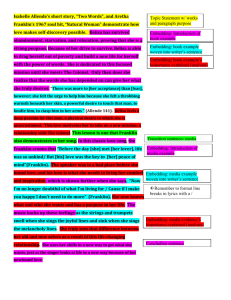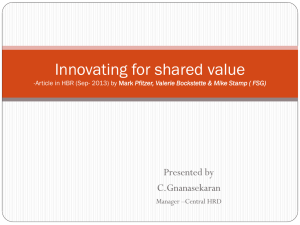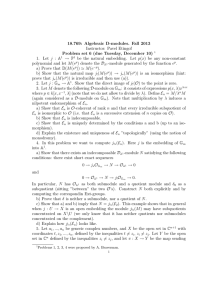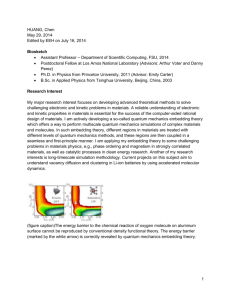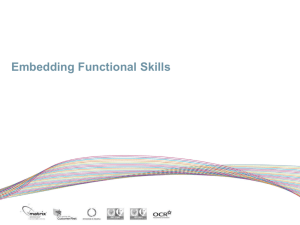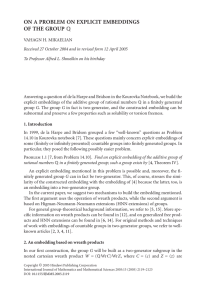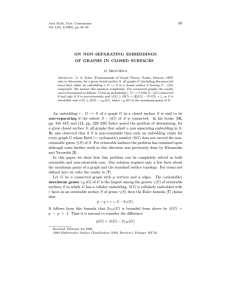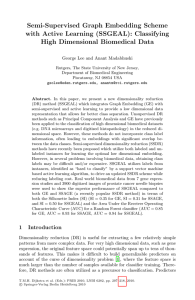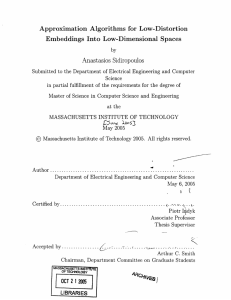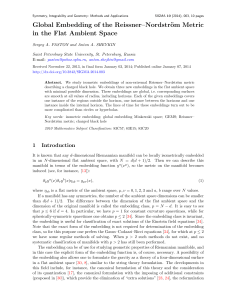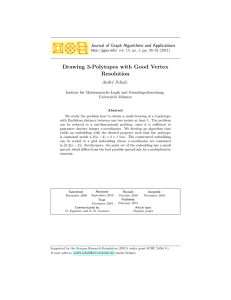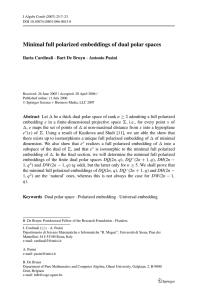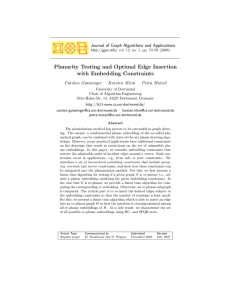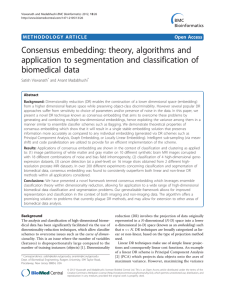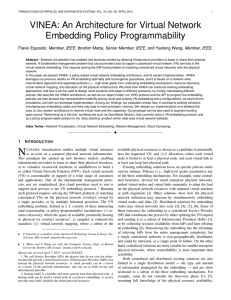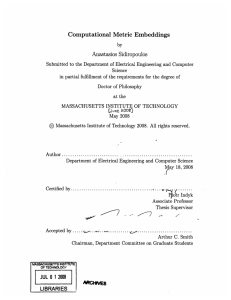Document 10443795
advertisement
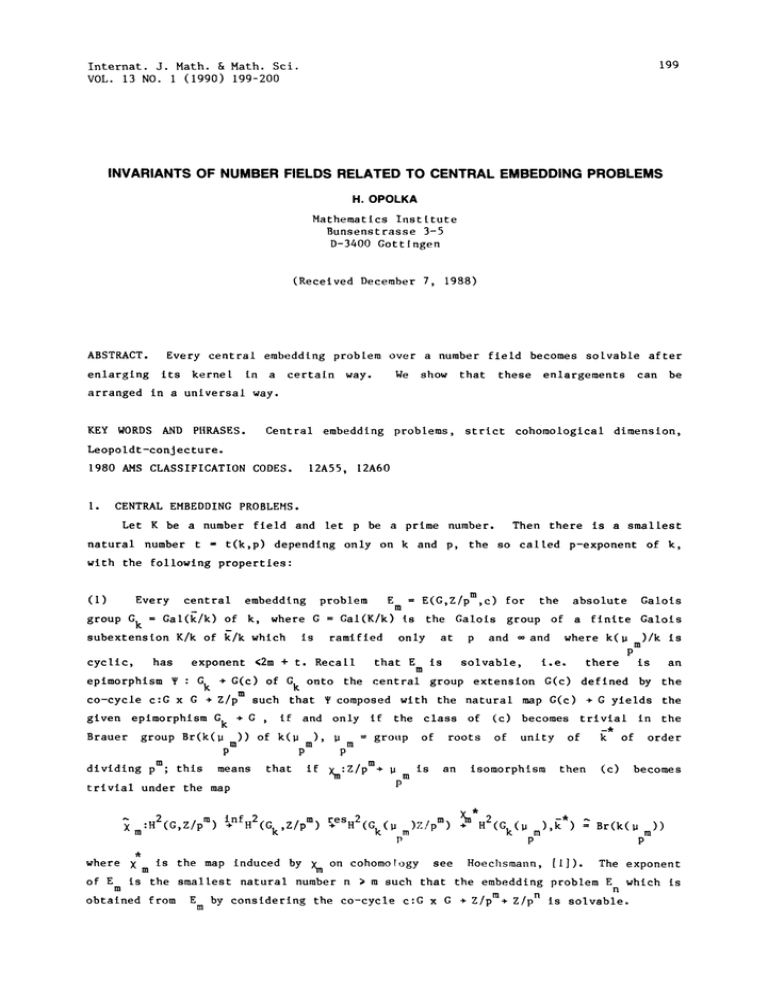
199 Internat. J. Math. & Math. Sci. (1990) 199-200 VOL. 13 NO. INVARIANTS OF NUMBER FIELDS RELATED TO CENTRAL EMBEDDING PROBLEMS H. OPOLKA Mathematics Inst[tute Bunsenst rasse 3-5 D-3400 Gott ngen (Received December 7, 1988) ABSTRACT. Every central embedding problem over a number field becomes solvable after We show that these enlargements can be enlarging its kernel in a certain way. arranged in a universal way. KEY WORDS AND PHRASES. Central embedding problems, strict cohomological dimension, Leopoldt-conjecture. 1980 AMS CLASSIFICATION CODES. I. 12A55, 12A60 CENTRAL EMBEDDING PROBLEMS. Let K be a number field and let p be a prime number. natural number t Then there is a smallest t(k,p) depending only on k and p, the so called p-exponent of k, with the following properties: E E(G,Z/p m,c) for the absolute Galois m Gal(K/k) is the Galois group of a finite Galois subextension K/k of k/k which ts ramified only at p and and where k( )/k is P has i.e. cyclic, that E is is exponent 2m + t. Recall there an solvable, m G / G(c) of G onto the central group extension G(c) defined by the epimorphtsm k k m G yields the co-cycle c:G x G / Z/p such that composed with the natural map G(c) G if and only if the class of (c) becomes trivial in the given eplmorphism G k _, Brauer group Br(k( )) of k( ), roots of unity of k of order groip of m m m P P P this means that if dividing is an isomorphism then (c) becomes m P trivial under the map (I) Every central Gal(/k) group G k problem embedding of k, where G pm 2 X m H (G Z/p m) Xm:Z/pm/ i+nfH2 (Gk z/Pm) r+esH2 (Gk( m )Z!p m) P H2(Gk( p m k )--Br(k(u P m )) is the map induced by where X on cohomology see Hoechsmann, [I]). The exponent m of E is the smallest natural number n > m such that the embedding problem E which is m n z/pm+ Z/p n is solvable. obtained from E by considering the co-cycle c:G x G Xm H. OPOLKA 200 In order to prove (I), choose for any natural number :z/Pm m and the m H2 (G,Z/ p m-m m such p that Xm. m Then we have a map Br(k( p m and X relating X m diagram resulting m an isomorphism ((c)) can Since commutes. )), be m represented by a Galols co-cycle all of whose values are roots of unity, the algebra class ((c))splits m and only if it splits locally at all places above p and and m and this is the case if it splits at pm for all v above p; E 0 rood P (see classels [2], p. 191, 10.5 ff). It is clearly possible to find a smallest integer (kv d P ):kv( m) ((c)) m d(k,p) depending only on k and p such that smallest d(Q,p) Q we can take d instance, for k natural number n ) that m such solution which is ramified only at p and the p-exponent of every E m is The p-exponent of E 0 for all p. the induced 2m + d. splits with is the has a n intege, r s )0 such that embedding The smallest m problem E For 2m + s is called the strong p-exponent of k (if it exists). (2) If p does not divide the class number of every cyclotomlc field k Q (pl) This can be shown as follows: t Let E m not divide the the strong p-exponent of be a central embedding problem for Gk. Then for t(k,p) the induced embedding problem that p does Q(Bp)then exists and is equal to its (usual) p-exponent. E2m + t is solvable. The assumption implies 0(Bpl)for every (see lwasawa [3]). class number of Therefore the Galols theoretic obstruction to the existence of a solution which is unramlfled outside p and as described in Neuklrch [4], (8.1), is trivial. H2(Gk(P),Q/Z) The p-adlc Leopoldt conjecture for k implies that is the Galols group of This shows and the maximal p-extenslon which is Gk(p) unramlfled outside p that every central embedding problem Ero for exponent, (see Opolka [5], (5.2)). finite? kP/k 0, where Gk(p) has finite p- Does this imply that the strong p-exponent of k is If so, how is it related to the usual p-exponent of k? strong p-exponent of k is finite then H2(Gk(P),Q/Z) Conversely, if the 0 and the p-adlc Leopoldt conjecture holds for k. REFERENCES 3. HOECHSMANN, K., Zum Einbettungsproblem, JRAM, 229(1968), 81-106. CASSELS, J.W.S., A. FrOllch: Algebraic Number Theory, Ac. Press, London, 1967. IWASAWA, K., A Note on Class Numbers of Algebraic Number Fields, Abh. Math. Sea. 4. NEUKIRCH, 5. Inventlones Math., 21 (1973), 59-116. OPOLKA, H., Cyclotom c Splitting Fields and Israel J. of Math., 52 (1985), 225-230. I. 2. Hamburg, 20 (1956), 257-258. J., Uber das Einbettungsproblem der Algebralschen Strict Zahlentheorle, Cohomologlcal Dimension,


